요약호형 사주는 동해안에서 흔히 분포하는 지형특징으로 고파랑시를 제외하고 리드미컬한 형상을 지속적으로 유지한다. 하지만, 2019년 9, 10월에 동해안에 직 간접적 영향을 미친 연속적인 4개의 태풍으로 인해 해안선과 평행한 연안사주가 형성되었고 해안선 부근에 침식과 퇴적이 반복되는 패턴을 보였지만 전반적인 해안선 후퇴가 발생하였다(약 2 m). 이와 같은 연속적인 폭풍파랑으로 인한 지형변화와 각 폭풍(NE-E 입사파) 이벤트의 영향을 모의하기 위해 폭풍 사상시 해빈의 침식 모의에 널리 사용되는 XBeach를 사용하였다. 개선된 XBeach 수치모의를 위해 최신 계수보정 연구 동향에 따라 계수보정이 실시되었으며, 이로부터 도출된 최적의 계수 값을 수치 모의에 적용하였다. 모델의 입력값으로 사용된 파랑, 조석 및 폭풍 사상 전후 수심 자료와 최적의 계수 값을 활용한 결과, 해안선 부근의 침식 및 퇴적 반복패턴(BSS = 0.77(침식 단면), 0.87(퇴적단면))과 해안선과 평행한 연안 사주의 형성을 성공적으로 모의하였다. 각 태풍의 최대 입사파고 도달 시 수치 모의된 전체 퇴적물 이동 벡터 및 지형변화 분석결과, 입사 파향이 호형 사주의 거동에 상당한 영향을 미치는 것으로 나타났다. 또한, 유의파고 크기뿐만 아니라 고파랑의 지속 시간 또한 퇴적물 이동량의 중요한 요인으로 판단 된다. 하지만 모델링 결과, 내측 쇄파대(inner surfzone)의 지형변화 및 연안 사주의 마루의 정확한 위치 예측을 위해서는 추가적인 보정과정이 필요함을 시사한다.
AbstractCrescentic sand bar in the coastal zone of eastern Korea is a common morphological feature and the rhythmic patterns exist constantly except for high wave energy events. However, four consecutive typhoons that directly and indirectly affected the East Sea of Korea from September to October in 2019 impacted the formation of longshore uniform sand bar and overall shoreline retreats (approx. 2 m) although repetitive erosion and accretion patterns exist near the shoreline. Widely used XBeach to predict storm erosions in the beach is utilized to investigate the morphological response to a series of storms and each storm impact (NE-E wave incidence). Several calibration processes for improved XBeach modeling are conducted by recently reported calibration methods and the optimal calibration set obtained is applied to the numerical simulation. Using observed wave, tide, and pre & post-storm bathymetries data with optimal calibration set for XBeach input, XBeach successfully reproduces erosion and accretion patterns near MSL (BSS = 0.77 (Erosion profile), 0.87 (Accretion profile)) and observed the formation of the longshore uniform sandbar. As a result of analysis of simulated total sediment transport vectors and bed level changes at each storm peak Hs, the incident wave direction contributes considerable impact to the behavior of crescentic sandbar. Moreover, not only the wave height but also storm duration affects the magnitude of the sediment transport. However, model results suggest that additional calibration processes are needed to predict the exact crest position of bar and bed level changes across the inner surfzone.
1. 서 론동해안의 대표적 근해(nearshore) 지형 특징인 호형 사주는 동해안 뿐만 아니라 전 세계적으로 분포하고 있으며, 각각 다른 지형적(straight, pocket beach) 특성 및 조차(tidal range, 0~4.5 m)의 시·공간적 스케일을 가진다(van Enckevort et al., 2004). 계절풍의 변화가 뚜렷하고 소조차의 해역환경특성을 가지고 있는 우리나라 동해안의 지형변화는 다양한 변동성을 가지는 해빈 상태(Wright and Short, 1984)를 보이지 않고 연속적인 고파랑으로 인한 근해의 지형변화와 호형 사주를 지속적으로 유지하는 특징을 나타내고 있다(Athanasiou, 2017). 일반적으로 호형 사주는 파랑 에너지 소산 효과로 해안선을 고파랑의 영향으로부터 보호하는 역할(Van de Lageweg et al., 2013)과 호형 사주의 지형적 변동성에 기인한 해빈 순환류(Nearshore circulation)가 해안선 변화(i.e. 파형 해안선, Megacusp)에 영향을 미치는 것으로 알려져 있다(Sonu, 1973; Castelle et al., 2010). 해안지역에서 침·퇴적 현상을 유발시키는 파고, 파향 및 지형조건 등의 다양한 요소들이 상호 복잡하게 작용하고 지역적 특징이 강하기 때문에 호형 사주의 거동 및 그로 인한 해빈변화의 정확한 현상규명이 어렵다. 하지만, 동해안과 같이 상대적으로 지속적인 호형사주 특징을 보이는 연안에서는 고파랑시 침식과 평상파랑 조건에서의 복원을 정확하게 예측하기 위해서 호형 사주와 그와 연관된 해빈 변동의 메커니즘을 이해하는 것은 필수적이다. 이러한 호형 사주의 메커니즘을 관측 자료를 통해 분석하기에는 한정된 자원에 의해 관측 자료가 시공간적으로 부족하기 때문에, 수치모형을 통한 메커니즘 규명 연구(Orzech et al., 2011; Razak et al., 2014; Smit et al., 2010)가 활발히 진행되고 있다.
현상기반 수치모형 XBeach(Roelvink et al., 2009)는 단기, 협역 폭풍사상시 모래해빈의 수리학적 및 지형 변화를 모의하기 위해 개발된 수치모형으로 소산형 해빈(Dissipative Beach)에서의 수치 모의에 초점을 두어 개발되었지만, 반사형 해빈(Reflecitve Beach) 및 맹방 해변과 같은 중간형 해빈(Intermediate Beach)의 모의 적용가능성 또한 다양한 연구를 통해 제기되었다(Orzech et al., 2011; Pender and Karunarathna, 2013; Razak et al., 2014; Vousdoukas et al., 2012; Chang et al., 2017; Son et al., 2017). Orzech et al.(2011)의 연구에서는 XBeach 수치모형 결과와 비디오 모니터링 관측자료와의 비교를 통해, 평균조차 1.6 m이고 상대적으로 해안선에 직각으로 입사하는 파랑이 지배적인 환경에서 호형 사주와 연관된 Megacusp의 위치는 평균해수면, 초기 지형조건, 파고가 핵심적인 역할을 하는 것으로 보고 되었다. 하지만 호형 사주가 횡단 또는 연안 표사에 큰 영향을 받는 고파랑 조건과 사선으로 입사하는 파로 인한 영향은 고려되지 않았다. Razak et al.(2014) 연구에서는 XBeach 모델을 통해 만형 해빈 조건에서 선행연구의 관측자료로부터 얻어진 패턴과 유사하게 쇄파대 부근의 해빈 순환류와 파랑 에너지에 따른 해빈 상태조건(Wright and Short, 1984)을 성공적으로 모의 하였지만 이상적으로 도식화된 지형자료를 모델 입력값으로 사용하는 한계를 가진다. Chang et al.(2017)의 연구에서는 XBeach를 통해 사주가 두드러지게 발달된 동해안 후정 해변에서의 폭 풍파랑에 대한 지형변화를 모의 하였지만, 모델의 입력값으로 사용된 수심 자료 관측 시기와 실제 폭풍파랑이 입사한 시기와의 간격이 크며 폭풍파랑 전·후 관측 자료가 존재하지 않아 수치 모의 성능에 대한 검증이 부족하다. Son et al.(2017)과 Do and Yoo(2020)의 연구에서 마찬가지로, 각각 호형 사주가 두드러지게 발달된 동해안 산포 해변과 우리나라의 대표적 만곡형 해변(embayed beach)인 해운대 해변에서의 폭풍파랑에 대한 지형변화를 XBeach를 통해 모의하였다. Son et al.(2017) 연구에서는 폭풍 파랑으로 인한 longshore uniform bar의 형성을 잘 재현하였으며, Do and Yoo(2020) 연구에서는 퇴적물 공급이 제한된 만곡형 해변에서 초기 지형의 모래 퇴적층 두께에 따라 지형변화 반응이 달라지는 것을 관측치와 유사하게 모의하였으나 두 가지 연구에서 진행된 수치 모의 모두 단일 폭풍파랑에 따른 영향만이 고려되었다.
선행 연구들의 관측자료분석 및 호형 사주에서의 수치모형 결과는 대부분 평상파랑조건, 이상적으로 도식화된 자료 및 단일 폭풍파랑 조건을 사용하여 검토되었으므로, 본 연구에서는 관측된 지형자료를 분석 및 활용하여 연속적인 폭풍파랑 조건에서의 호형 사주 반응과 그로 인한 해안선 부근의 반응을 검토하였다. 이를 위해 2019년 9월, 10월 맹방해변에 직간접적으로 영향을 준 4개의 태풍(No.13 Lingling, No.17 Tapah, No.18 Mitag, No.19 Hagibis) 전·후 수심 관측을 시행하였고 2017년 3월부터 약 34개월간 수심 자료와 비교 분석하였다. 또한, 맹방 해변의 계절적 및 태풍 시 파랑 패턴과 표사 이동 간의 연관성을 분석하기 위해 2013년 11월부터 약 6년간 관측된 수압식 파고계자료가 사용되었다. 마지막으로 폭풍 발생시기의 파랑 자료와 태풍 전 수심 측량자료를 XBeach 수치모형 입력자료로 사용하여 폭풍 사상 시 입사되는 고파랑으로 인한 호형 사주의 반응과 그로 인한 해안선 부근의 침·퇴적 현상을 수치 모의하였다.
2. 연구 지역 및 관측자료2.1 대상해역본 연구에서는 인위적인 영향이 제한적이면서 호형 사주가 발달한 강원도 삼척시 맹방 해변을 대상으로 현장 관측 및 수치모델링 연구를 수행하였다. 맹방 해변은 북으로부터 평균 약 41.6도 기울어진 준(quasi) 직선형의 개방 해안으로 북쪽 오십천과 남쪽 마읍천 하류의 덕봉산 사이에 위치하여 한재 밑, 상맹방, 하맹방, 맹방 해변으로 구분되지만 본 연구에서는 이를 통틀어 맹방 해변으로 간주하였다(Fig. 1). 전체적인 백사장의 길이는 약 4.5 km이며 평균적으로 약 50 m의 해빈 폭을 보이지만 호형 사주의 발달 위치에 따라 최소, 최대 해빈 폭 차이가 약 100 m 내외의 크기를 가져 지점별 변동 폭이 큰 특징을 가진다. 해저면의 평균 경사는 약 1:30~1:40으로 완만한 편에 속하며, 계절에 따라 호형 사주의 위치는 변동되지만 사주는 지속적으로 발달한 특성을 가진다. 평균 조차는 약 16.9 cm로 조류의 영향이 크지 않은 저조차 환경이며 동해안의 북서 방향으로의 긴 취송 거리로 인해 해안선의 직각으로 입사하는 파랑(NE 방향))이 우세한 환경(Cho and Kim, 2019)이지만 계절에 따라 E 또는 N 방향으로도 파랑이 내습하며 이는 해빈류의 발달, 표사이동 및 호형 사주의 형성에 많은 영향을 미친다.
2.2 파랑자료맹방 해변 중앙부 수심 약 30 m에 설치된 초음파식 파고계(AWAC, W1)와 전국 파랑 관측 자료 제공시스템(WINK)에서 관측(Fig. 1) 된 맹방 자료의 유의파고, 첨두주기, 첨두파향, 횡 방향(alongshore) 파랑 에너지 플럭스(Van de Lageweg et al., 2013) 및 파랑 장미도 분석결과, 전반적으로 해안선 직각으로 입사하지만 계절적으로 하계(NE-E, lower wave energy)와 동계(N-NE, higher wave energy)의 특징을 보인다(Fig. 2). 횡 방향 성분의 파랑 에너지 플럭스의 양과 음의 값은 각각 NW 방향과 SE 방향의 에너지 플럭스의 우세 정도를 나타내며 하계(NE-E 계열) 및 동계(N-NE 계열) 입사 방향 및 파고 크기에 따라 유사한 크기와 방향을 가진다. 입사 파향 및 파고의 크기와 일치하게 NW 방향의 연안표사(하계), SE 방향의 연안표사(동계)가 반복 회귀하는 계절적인 특징(Cho and Kim, 2019)을 가지며 간헐적인 태풍으로 유발된 사선으로 입사하는 고파랑의 높은 횡 방향 에너지 플럭스로 인해 연안 표사에 많은 영향을 미칠것으로 사료된다.
2019년 발생한 태풍 29개 중 우리나라에 직 간접적으로 영향을 미친 태풍은 7개로 그중 맹방 해변에 2019년 9월, 10월 직 간접적으로 영향을 미친 4개의 태풍으로 인한 파향 특성은 평균 해안선 수직 방향(41.6°) 기준 동측 사선으로 입사하는 폭풍파랑과 상대적으로 수직으로 입사하는 폭풍파랑 2가지로 구분될 수 있다(Table 1, Fig. 3). 2019년 9월 태풍 Lingling과 Tapah가 우리나라 서, 동해안 부근을 내습하였을 때 E, ENE 계열의 파랑이 입사하였고, 10월 태풍 Mitag과 Hagibis가 우리나라 동해안 및 일본 동측 해안 부근을 내습할 시 NE, ENE 계열의 파랑이 지배적으로 맹방해변에 영향을 미쳤다. 태풍 Lingling은 중심 최소기압 940 hpa, 중심 최대 풍속 47 m/s(KMA, 한국 기상청 기준)으로 세력 ‘강’으로 우리나라 서해안에 영향을 주었으나 서해상으로 진행된 태풍 경로로 인해 Fig. 1의 W1 지점에서의 최대 유의 파고는 1.72 m, 첨두주기 7.19초, 1 m 이상의 유의 파고 지속시간 12시간으로 비교적 낮은 파고를 가진 파랑이 입사하였다. 태풍 Tapah가 내습할 당시 최대 유의파고는 4.52 m, 첨두주기 10.19초, 2 m 이상 유의파고 지속시간 49시간으로 모의 기간 중 가장 높은 파고가 입사하였으며 태풍 Mitag이 내습할 당시 최대 유의파고는 3.76 m, 첨두주기 10.7초, 2 m 이상 유의파고 지속시간 77시간으로 긴 지속시간을 가진 해안선에 수직한 방향의 고파랑이 입사하였다. 태풍 Hagibis의 경우 일본 동측 해안 부근을 내습 하였지만 지속적인 바람에 세기에 따라 열대 폭풍을 분류하는 SSHS(Saffir-Simpson Hurricane Scale) 기준 5등급 및 태풍 직경이 약 1400 km에 달하는 초강력 태풍(KMA, 한국 기상청) 으로 한반도 동해안 또한 영향을 미쳤다. Hagibis가 내습할 당시 최대 유의파고는 4.24 m, 첨두 주기 10.54초, 2 m 이상 유의파고 지속시간 약 67시간으로 NE-ENE 계열 고파랑이 우세하였다. 또한 4개의 태풍 시기의 횡 방향 성분의 파랑 에너지 플럭스 분석결과(Fig. 2) 이러한 연속적인 폭풍파랑으로 인해 많은 양의 북향 연안표사가 발생할 것으로 사료된다.
2.3 수심자료수심 및 해빈 단면 측량은 RTK-GNSS와 고정밀 GNSS, 정밀음향측심기(AquaRuler 200S, MIDAS)가 장착된 조사선들로 진행되었으며 쇄파대 외측 MSL(-) 25 m부터 해수면 위 기준점 MSL(+) 6 m까지 조사되었다. 2017년 3월부터 2019년 12월까지 약 34개월 동안 진행된 22번의 수심 관측 결과 MSL(-) 10 m 외측의 지형변화는 거의 일어나지 않았으므로 모래이동한계수심(depth of closure)은 수심 MSL(-) 10 m 부근에 형성된 것으로 판단된다. 전체 관측기간동안의 평균 수심등고선 분석결과 Fig. 4a와 같이 호형 사주가 지속적으로 발달(Fig. 4c)되는 것으로 사료되며 호형 사주의 위치와 연관되어 해안선의 전진 후퇴과 반복되는 패턴을 보인다. 2019년 9월~10월 4개의 태풍 전(2019년 8월 29일) 후(2019년 10월 30일) 수심자료 비교 결과 MSL(-) 3~MSL(-) 5 m 수심의 모래가 MSL(-) 5~MSL(-) 7 m로 이동 및 퇴적되어 수심이 2 m 가량 증가하였으며 기존에 반영구적으로 유지되던 호형 사주는 태풍 사상 후 해안선과 평행하는 longshore uniform sandbar를 형성하였다(Fig. 4b, d). 뿐만 아니라, 지속적으로 발달된 호형 사주의 지형적 특성과 연관된 해안선 후퇴와 전진의 반복적인 패턴은 태풍 사상 후 수심 자료에서 관측되었다(Fig. 4d). 파랑 및 수심자료 분석결과 계절적인 파랑 특성의 변동성과 간헐적인 고파랑 및 호형 사주의 지형적 변동성이 강하기 때문에, 맹방 해변의 호형 사주의 거동과 그로 인한 해빈 반응의 정확한 예측을 위해서는 횡단, 연안 표사 및 해빈 순환류 기인 표사이동 또한 고려해야 하는 것으로 판단된다.
3. XBeach 수치모형 입력자료 및 계수보정3.1 XBeach 수치모형 입력자료XBeach 모델은 태풍과 같은 고파랑 시의 지형변화를 예측하기 위해 총 3가지의 옵션(Stationary, Surfbeat, Non-hydrostatic mode)을 가지고 있다. 이를 간략히 설명하면, Stationary mode는 파랑 변형 해석 시 파랑 에너지 방정식(Deltares, 2018)을 이용하는 것으로 계산 기간은 빠르지만, 고파랑 시에 포함된 장주기성의 너울 성분을 연산하는 데 한계가 있다. Surfbeat mode는 이러한 단점을 해결하기 위해 단주기성의 성분은 파랑 에너지 방정식을 장주기성의 파랑은 비선형 천수방정식을 통해 해석하여 포말대에서의 처오름 및 모래이동을 정밀하게 모의하는데 장점을 가지고 있다. Non-hydrostaic mode는 파랑의 전 주파수에 대해 비선형 천수 방정식을 적용한 것으로 모래이동 및 지형변화를 연산할 수 있도록 배포되었지만, 다수의 계산시간으로 인하여 현장 적용에는 한계가 있는 것으로 알려져 있다. 본 연구에서는 앞에서 서술한 바와 같이 2019년에 연속적으로 내습한 태풍에 의한 지형변화를 모의하기 위해 Surfbeat Mode를 사용하였으며, 이를 위한 입력 조건은 다음과 같이 구성하였다.
수치 모델의 외해 파랑 경계조건으로 AWAC(Fig. 1, W1)의 유의파고(Hs), 첨두주기(Tp), 첨두파향(Dp) 및 directional spreading(s) 자료를 이용하였으며 2차원 JONSWAP 스펙트럼을 적용하여 태풍 시 파랑 변형, 쇄파, 해빈류, 모래이동 및 지형변화를 모의하였다. 그리고, 폭풍으로 인한 수위 상승과 조석으로 인한 해수면 변동을 고려하기 위한 외해 수위 조건은 국립해양조사원의 동해항 조위 관측소 자료(고유번호 257-02)를 사용하였다. 2차원 수치모델의 격자는 계산 시간의 효율을 위해 곡선형의 가변 격자(Fig. 5)를 적용하였으며, 격자의 크기는 해안선 수직 방향으로 부터 외해에서 약 7~12 m, 파랑 변형 및 지형변화가 크게 발생하는 쇄파대 인근과 포말대 지역에서는 1.5~6.0 m로 구성하였다. 해안선 평행 방향 또한 유사하게 주요 관심지역(맹방해변)에서는 약 18 m, 맹방해변 우측 덕산해변에서 약 38 m의 격자 해상도를 가지도록 구성하였으며 총 210(cross-shore) x 306(alongshore) 격자를 구성하여 맹방 해변(마읍천 좌측)과 덕산 해변(마읍천 우측)을 모두 포함하도록 하였다. 수치모형의 수심은 태풍 전 수심측량자료를 사용하였으며 암반 저질 및 해안도로에 해당하는 부분은 침식이 일어나지 않는 층(non-erodible layer)으로 간주 된다. 모든 2D 수치 모의는 2018년 10월에 배포된 XBeachX 1.23.5527 version을 사용하였으며 수치 계산시간을 줄이기 MPI(openmpi)를 사용하여 36개의 노드를 병렬작업처리하였다.
3.2 계수보정 개요XBeach와 같은 연안 지형변화 모델은 파랑의 쇄파 및 모래이동에 대한 매커니즘의 이해도 부족으로 인해 다수의 경험식을 가지고 있으며 이로 인하여 다수의 경험 상수를 필요로 한다. 초창기 XBeach 개발 시에 제안된 경험상수 값은 폭풍에 의한 방호섬(barrier island) 붕괴를 모의하기 위해 설정되었다. 그로 인해, 해빈 조건하에서는 외해 방향으로의 모래 이동과 지형변화를 과대평가하는 한계를 가지고 있으며 이를 해결하기 위해 다양한 계수보정 방법이 개발 및 적용되었다(Do et al., 2018; Elsayed and Oumerac i, 2017; Mc Call et al., 2010). Orzech et al.(2011)의 연구에서는 최적의 매개변수 산정을 위해 계수들의 단순 반복 계산과 연구자의 경험에 의존하는 일반적인 시행착오법(Trial and error)을 사용하였다. 또한 XBeach의 퇴적물 이동 방정식의 equilibrium sediment concentration과 관련된 경험식[Soulsby-Van Rijn 식(Soulsby, 1997)과 Van Thiel-Van Rijn(van Rijn, 2007)]을 비교하여 전자의 식이 호형 사주와 해안선 변동 수치모의 시 적합하다는 것을 관측자료를 토대로 설명하였다. De Vet.(2014)은 수치 모델을 물리적 현상에 기반하여 모델의 정확도를 향상시키기 위해 모래의 체적 변동에 따른 저항도의 변형(dilatancy), 부유사 농도에 따른 모래 입자 침강속도의 영향(fallvelred), 지형경사에 따른 모래 이동의 방향과 안정성 변화(bdslpeffdir, bdslpeffini)를 고려할 수 있는 경험식들을 적용하였으며, 다양한 파랑 및 지형 조건하에 수치모의 정확도를 검증하였다. Passeri et al.(2018) 연구에서는 포말대에서의 모래 이동 및 지형변화 예측 능력을 향상하기 위해 지형의 특성에 따라 마찰계수(C, chezy coefficient)를 달리하는 방법을 통해 수치모델의 정확도를 개선하였으며, 마찰 계수 매개변수를 다양한 선행 연구에서도 계수보정 값으로 사용되고 있는 추세이다(De Vet, 2014; Orzech et al., 2011).
최근에는 모래이동에 직접적으로 영향을 미치는 파랑 변형 및 쇄파현상의 예측 정확도를 향상시키기 위해 모델을 개선하는 연구도 적극적으로 수행되고 있다(Daly et al., 2012; Roelvink et al., 2018). 이를 간략히 설명하면, XBeachX 수치모델에서 파랑의 쇄파를 예측하기 위해 사용되는 roelvink93 쇄파 방정식(Roelvink, 1993)은 쇄파에 의한 파랑에너지 소산(dissipation)을 추정하기 위해 불규칙 파랑이 쇄파될 확률을 쇄파계수(gamma, γ) 값과 수심, 파고 비를 이용하여 경험적으로 산정하였다. 하지만, 이와 같은 방법은 bar-trough system과 같이 급격히 수심이 증가 되는 지역에서 실제 쇄파에 의한 소산 정도에 비하여 과소평가되는 한계성이 보고되었으며, 이를 보완하기 위해 쇄파가 발생 될 조건을 쇄파계수와 수심비에 따라 쇄파 발생 유무를 binary 값으로 결정하고 그것이 파속과 함께 이류되는 advective-deterministic한 접근법이 개발 및 모델에 적용되어 단파와 장파성분의 파고와 이로 인한 해빈류의 정확도를 향상시켰다(Daly et al., 2012). 또한, 단주기성 파랑성분을 모의하기 위해 XBeach에서 사용되는 2차원 파랑 에너지 방정식 옵션인 multi-dir과 그로부터 도출된 장주기성 성분의 포말대에서의 처오름이 부정확하게 모의하는 것으로 알려지면서, 이를 해결하기 위해, stationary 조건 하에 평균 파향을 먼저 산정한 후 간소화된 방정식을 사용하는 single-dir 옵션이 사용되었다(Roelvink et al., 2018). 이는 앞서 언급한 daly 쇄파식과 함께 전반적으로 장파와 단파의 파고 및 유속을 더욱 정확하게 수치모의하는 것으로 나타났다. 따라서 계수보정에 관한 사전 연구를 토대로 본 연구에서의 수치 모의 계수보정 과정은 다음과 같다(Fig. 6).
De vet.(2014)에서 언급된 dilitancy, fallvelred, bdslpeffdir, bdslpeffini 옵션과 Soulsby식을 사용하여 퇴적물 이동을 계산하며, 먼저 single-dir과 multi-dir 그리고 쇄파 산정식 간의 모의 성능을 비교하였다. 이후 최적의 계수 보정 값을 찾기 위해 쇄파계수 gamma(γ), 중앙입경(D50), 바닥 마찰계수(C, chezy coefficient) 각각의 매개변수 영향을 분석하였으며, 부차적으로 계수보정 과정의 수치 모의 계산시간을 줄이기 위해 morfac(morphological acceleration factor, 지형 변화 가속화 계수) 민감도 분석을 실시하였다. 사용된 중앙입경 값은 해저질 입도분석 관측 결과를 통해 산출되었고, 나머지 자유 매개변수들은 기본 설정된 값을 사용하였다. XBeach 수치 모의 결과의 정량적 평가는 BSS(Brier Skill Score, 식(1), van Rijn et al., 2003)에 근거하며 값의 범위에 따라 1.0-0.8 (Excellent), 0.8-0.6(Good), 0.6-0.3(Reasonable/Fair), 0.3-0 (Poor), < 0(Bad)로 분류된다. zb, c, zb, m, zb, 0는 각각 수치 모의, 관측, 초기관측된 bed level 값을 의미하며 ∆zb, m는 관측된 bed level의 오차를 의미하나 본 연구에서는 BSS 계산 시고려되지 않았다. 계수 보정 시 BSS는 포말대에서의 모래이동 및 지형변화 예측능력을 평가하기 위해 MSL(±) 0 m부터 MSL(+) 4 m 지점까지 진행 되었으며, 폭풍 후 관측 및 수치 모의된 해빈 단면과 태풍 전 관측 해빈 단면이 사용되었다.
3.3 계수보정 결과본 연구에서는 3.2절에서 서술한 바와 같이 XBeach 모델 내의 주요 매개변수에 대한 계수 보정을 수행하였으며 Fig. 6의 Flow chart에 따라 총 10가지의 계수 보정(Case 1~10) 케이스로 분류 할 수있다. 각 케이스별 해당되는 계수보정 값과 수치모델링 정확도 평가를 위한 BSS 값은 다음과 같다(Table 2). BSS 평가는 72번 부터 246번 해빈 단면까지 총 175개의 관측 자료(참고 Fig. 9)를 이용하여 진행되었으며, Table 2의 가장 우측에 제시된 BSS와 괄호 안의 값은 전체 프로파일 중에 정확도가 높은 기준에 해당하는 BSS 값이 0.3 이상의 경우(Reasonable/Fair)에 해당하는 총 BSS 합과 그에 해당하는 해빈 단면의 총 개수를 각각 의미한다. BSS 평가 결과, 값이 0.3 이상에 해당하는 해빈 단면은 주로 초기 지형의 호형 사주 배후에 위치한 해안선의 후퇴가 발생한 부근이며, 폭풍파랑 내습 후 해안선 변화가 거의 없거나 전진한 부근의 BSS 값은 상대적으로 후퇴가 발생한 부분에 비해 낮은 값을 보이는 것으로 나타났다.
본 연구에서는 맹방 해변에 적합한 산정식과 매개변수를 판별하기 위해 수행된 계수보정 과정에서 상대적으로 긴 수치모의 기간(약 2달)이 필요하지만, 계산시간을 줄이기 위해 Case 8(morfac= 1)을 제외하고 나머지 케이스의 경우 morfac을 10으로 설정하였다. morfac으로 인하여 발생 되는 수치모델의 민감도 분석 결과, 동일한 계수 조건하에서 morfac= 1 과 10의 경우(각각 Case 8과 6) 총 BSS 합의 차이가 2.38로 미미하며, 이는 지형변화 가속화 계수에 의한 전반적인 지형 변화 모의 결과 차이가 거의 없음을 의미한다. 이와 동시에, 수치모델의 계산 시간을 감소시키기 위해 외해에서 파랑이 0.5 m 이하로 발생 하였을 경우에는 이를 수치 모델 계산에 포함하지 않았으며(Case 2), 이로 인한 수치모델의 차이를 검증하기 위해 모든 파랑 조건을 고려한 Case 1과 비교한 결과 총 BSS 합의 차는 3.04로 그리 크지 않았다. 이를 토대로, Case 2~10까지의 수행한 계수보정과정에서는 0.5 이상의 파랑 조건만을 수치 모의에 고려하였다.
먼저 Fig. 6의 flow chart 순서에 따라 두가지 파랑 에너지방정식 옵션(single-dir and multi-dir) 및 쇄파 방정식 간(daly and roevink93)의 수치모의 성능을 비교하였다. Singledir과 multi-dir 옵션(Case 2와 3) 사용 시 총 BSS 합의 차이는 2.63으로 미미하나, single-dir 사용시 쇄파대 에서의 침, 퇴적(longshore uniform bar 생성)이 과소평가 되는 경향을 보였다. Daly 쇄파 산정식을 사용하였을 때(Case 3) roelvink93 산정식(Case 4)보다 총 BSS 합이 16.87 컸으며 roelvink93 산정식을 사용하였을 때 수심 MSL(-) 3~MSL(-) 5 m 부근의 침식현상(Fig. 4d)을 과소평가할 뿐 아니라 평균 해수면 위의 모래 이동과 그로 인한 침식현상이 과대평가 되었고 퇴적 현상을 재현하지 못하였다. 따라서 본 수치모의에서는 multidir 옵션과 Daly 쇄파 산정식을 사용하였을 때 지형변화 수치 모의 정확성이 더욱 뛰어난 것으로 판단된다.
실제 해저에서의 모래 입경은 수심에 따라 다르게 분포(외해방향 세립화, seaward-fining)하는 것과 달리 수치모델에서는 균일 입경으로 가정한다. 이에 사용자들은 어떤 중앙입경(D50)을 모델 입력값으로 사용하는 것이 적합한지를 판단함에 있어 모호함을 가진다. 이에 대한 기초자료를 제공하기 위해 본 연구에서는 다른 입경에 따른 모델의 민감도를 분석하였다. Fig. 7은 2019년 7월 29일, 맹방해변의 육상 12점(A01~L01, MSL(±) 0 m), 해상 36점(A02~L04, 각각 MSL(-) 3, 6, 9 m) 총 48개의 정점에서 실시된 해저질 조사 분석결과를 나타내며, 평균 해수면 부근(A01~L01) 평균 중앙입경은 약 0.65 mm로 coarse sand, 전체 정점(A01~L04)에서의 총 평균 중앙입경은 약 0.4 mm으로 medium sand로 분석되었다. 수치 모의 시 두 가지 중앙입경 모두 고려한 결과 0.4 mm 중앙입경을 사용하였을 때(Case 6) 0.65 mm 중앙입경(Case 9) 보다 총 BSS 합이 30.22 컸으며 0.65 mm 중앙입경을 사용하였을 때 평균해수면 위의 모래 이동과 그로 인한 침식 현상이 과소평가 되었고 모든 해수면 위 수치 격자 영역에서 퇴적이 발생하였다. 또한, 0.4 mm 중앙입경을 사용하였을 때 태풍 시 고파랑으로 인해 침식된 모래가 외측으로 이동하여 더욱 깊은 수심에서 퇴적되는 경향을 보였다. 이는 중앙입경 0.5 mm를 기준으로 퇴적물 이동 산정식 형태가 바뀌는 것(Deltares, 2018) 에 따라 모래의 침식 및 퇴적의 거동에 큰 영향을 미치는 것을 의미한다. 결과적으로, 본 연구의 대상해역인 맹방 해변에서는 모델 입력값으로서 중앙입경 산정 시 전체 수심 약 MSL(-) -9~MSL(±) 0 m 부근에서 총 평균된 중앙입경 0.4 mm를 사용하는 것이 적절한 것으로 사료된다. 추가적으로, 앞서 3.2절에서 소개된 바와 같이 지형적 특성에 따라서 바닥 마찰계수가 다르며 맹방 해변과 같이 barthough가 패턴이 반복적으로 발달되어 있는 지역에서는 적절한 쇄파계수를 산정하는 것이 중요하므로, 본 연구에서는 바닥 마찰계수와 쇄파 계수를 활용한 계수보정을 진행하였다. 민감도 분석 결과, 쇄파 계수 값이 커질수록 쇄파에 의한 파랑 에너지 소산이 적게 일어나 전반적으로 MSL 부근에서 침식이 더욱 크게 발생 하게되고 고파랑시 외측으로 모래 이동이 더욱 많이 발생하였다. 또한 쇄파대와 천수역에서의 바닥 마찰 계수 값이 커질수록 상대적으로 깊은 수심에서의 퇴적물 이동이 더욱 활발히 일어나는 경향을 보였으며, 쇄파계수 값 0.7과 바닥 마찰계수 40 m0.5/s일 때 BSS 값이 가장 높게 나타났다. 결과적으로 폭풍 사상시 입사되는 고파랑으로 인한 호형 사주의 반응과 그로 인한 침 퇴적 현상을 수치 모의하기 위해 본 연구에서는 multi-dir 옵션, daly 쇄파방정식, morfac= 1, gamma = 0.7, D50 = 0.4 mm, C = 40 m0.5/s(Case 8, 총 BSS 합 = 38.87)을 최적의 계수 set으로 사용하였다.
4. XBeach 수치모의 결과본 연구에서는 3.3절에서의 결과로부터 도출된 최적의 계수 set을 사용하여 맹방 해변의 지형변화를 수치모의 하였으며, Fig. 8은 초기 지형 등고선과 각 태풍 내습시 최대 파고 시점(Table 1)에서의 수치 모의된 수심 차이와 표사 이동 방향 및 크기를 나타낸다. 먼저, 맹방 해변에 영향을 미친 태풍의 특성을 분석해보면, 태풍 Lingling은 중심 최대풍속이 47 m/s 로 한국 기상청(KMA) 기준 ‘강’의 태풍이었지만 서해상으로 진행된 태풍 경로로 인해 파랑 에너지가 그리 크지 않았다. 파향은 바람의 방향으로 인해 E 계열의 파랑이 발생하여 전반적인 모래의 이동은 북서 방향이 우세하였으며, 이로 인해 수심 MSL(-) 2 m 이내에서 침식 및 퇴적이 반복되는 패턴을 보였다(Fig. 8a). 연구 기간 중 태풍 Tapah가 내습하였을 경우 가장 높은 파고(4.52 m)가 입사하였으며, Lingling 발생 시와 유사하게 ENE 계열의 파랑으로 인해 전반적인 표사 이동은 북서진 하며 상대적으로 높은 파랑 에너지로 인해 쇄파대에서의 지형변화가 크게 발생하였으며 이로 인하여 호형 사주는 해안선 평행 방향으로 이동되는 패턴을 보였다(Fig. 8b).
태풍 Mitag이 내습할 당시에는 기존의 두 태풍과 다르게 해안선 수직한 방향의 고파랑이 발생하여 횡단표사가 우세하게 발생하였으며, 태풍 Tapah의 경우에는 파고는 상대적으로 낮았지만, 2 m 이상 고파랑이 상대적으로 길게 발생하여 MSL(-) 3~MSL(-) 5 m 수심에 위치한 많은 양의 모래가 외해 방향으로 이동하여 수심 MSL(-) 5~MSL(-) 7 m 부근에 퇴적되었다(Fig. 8c). 이는 긴 재현주기를 가지는 단일 폭풍 파랑보다 조금 짧은 재현주기를 가지는 연속적인 폭풍파랑으로 인해 더 많은 침식을 일으킬 수 있다고 보고된 선행 연구 결과(Castelle et al., 2015)와 유사하다. Hagibis 내습시 수치모의 기간 중 두 번째로 큰 파고(4.24 m)가 발생하였으며, 파향은 NE-ENE 계열이 우세하였다. 높은 파랑에너지(고파랑과 긴 지속 시간)으로 인해 Mitag 내습시와 유사하게 횡단 표사가 우세하였으며 많은 양의 모래가 MSL(-) 5~MSL(-) 7 m 부근에서 퇴적되었다. 하지만 Mitag 내습시와는 다르게 NE-ENE 계열 입사파랑으로 인하여 북향으로의 연안 표사도 크게 발생하였다(Fig. 8d). 이를 통해, 폭풍파랑의 입사 방향은 호형 사주의 변화에 큰 영향을 미치게 되며(oblique wave: alongshore directed movement, shore-normal wave: crossshore directed movement), 유의파고의 크기 뿐만 아니라 고파랑의 지속시간도 연안 지역의 지형변화에 영향을 미치는 주요 인자임을 다시 한번 확인하였다.
Fig. 9는 초기 지형 수심과 4개의 태풍 내습 2주 후(2019년 10월 30일)에 관측한 수심자료, 그리고 XBeach 수치 모델링 결과를 보여주고 있으며, 모델의 정확도를 평가하기 위해 수치 격자 72번부터 246번까지의 수심 MSL(-) 2~MSL(+) 4 m의 BSS 평가를 진행하였다. Fig. 9에서 pf119와 pf218의 관측 자료는 해안선 부근에서 침식, 퇴적이 우세한 대표적인 해빈 단면으로 수치모의 결과 수심 MSL(-) 2~MSL(+) 4 m 에서의 침식과 퇴적을 성공적으로 모의하였다(BSS = 0.77 (Good), 0.87(Excellent), respectively). 침식 해빈단면(pf119)에서 longshore sandbar의 trough의 위치는 비교적 정확히 모의하였으며 crest의 위치는 관측 결과보다 더욱 깊은 위치에서 재현 되는 한계를 보였지만, 전체적으로 맹방 해변의 관측 결과와 유사한 경향을 가진 것으로 분석된다. 퇴적 해빈 단면(pf218)에서의 모의 결과를 분석해보면 수심 MSL(-) 2~ MSL(+) 4 m에서 발생한 퇴적 현상은 재현하였지만, innerbar와 outerbar와 같은 연안 사주의 생성에는 그 정확도가 낮았으며 이는 대형수리모형실험 자료를 이용한 선행 연구(Do et al., 2018)와 일치한다. 그리고, 덕봉산 및 마읍천(pf234~246) 해안선 부근에서 뚜렷한 지형변화가 발생하지 않았지만 XBeach 모의 결과 약 1.5 m의 침식이 발생하였다. 이는 태풍 미탁 내습 시, 많은 강수량으로 인한 마읍천으로부터 모래공급이 수치 모의 시 고려되지 않아 발생한 원인으로 하천에서의 모래 유입량이 수치 모의 시 고려되어야 함을 시사한다. 요약하면, 본 연구에서 사용한 최적의 계수 세팅은 inner surfzone(inner bar formation)에서의 지형변화와 longshore uniform bar crest의 위치를 정확하게 재현하지는 못하였으나, 전반적인 MSL 부근의 침식 및 퇴적이 반복되는 경향과 북향 연안표사 및 횡단표사로 인한 longshore uniform sandbar의 형성을 성공적으로 재현하였다.
5. 결 론본 연구에서는 현상기반 XBeach 모델을 활용하여 다양한 특성의 폭풍파랑으로 인한 맹방해변의 호형 사주 반응과 해안선의 침식 및 퇴적 현상을 모의하였다. 관측 파랑 자료 분석결과 맹방 해변으로 입사되는 파랑은 계절적인 특징(하계: NE-E, 동계: N-NE)을 보이며 2019년 9월, 10월에 한반도에직, 간접적 영향을 미친 4개의 태풍으로 인한 폭풍파랑은 다양한 파향(NE-E)과 파고(1.7~4.5 m)를 가진다. 파랑 및 수심 자료 분석결과 전술한 내습 태풍으로 인한 폭풍파의 영향으로 지속적으로 유지되었던 호형 사주가 사라지고 longshore uniform sand bar가 형성되었으며 전체적으로 북서진의 표사이동이 우세하였다. 해안선 부근의 지형은 침식과 퇴적이 반복되는 패턴을 보였으나 연속적인 고파랑의 영향으로 평균적으로 2 m 가량의 해안선 후퇴가 발생하였다. 이와 같은 폭풍 파랑에 의한 지형변화를 수치 모의하기 위해 수압식 파고계로부터 관측된 시계열 파랑 자료와 동해항 조위 관측 자료를 모델 입력값으로 사용하였으며 수치 모의에 소요되는 계산시간을 줄이고 정확도를 높이기 위해 가변격자(Curvilinear & non-equidistance grid)를 사용하였다. 폭풍파랑 내습시 맹방 해변에서 적합한 계수보정 값을 찾기 위해 시행착오법(Trial and Error)을 사용하였으며, 추가적으로 XBeach 모델에서 사용되는 쇄파산정식 및 파랑 에너지 전파식 간의 성능을 비교하여 맹방 해변의 특성에 적합한 수치모델을 구성하였다. 최적의 계수 도출 및 수치모델의 정확도 평가는 태풍 후의 현장 관측자료와 수치 모의 결과를 이용하여 도출한 BSS 값을 이용하였으며 이를 Table 2에 나타내었다. 이를 분석해보면 수치모델 내에서는 multi-dir 옵션과 daly 쇄파방정식을 사용하였을 경우가 정확도가 높았으며, 매개변수는 morfac= 1, gamma = 0.7, D50 = 0.4 mm 및 C = 40에서 최적의 BSS를 나타내어 이를 수치모델링에 활용하였다.
XBeach 모의 결과를 분석해보면, 태풍 Tapah로 인한 고파랑시 ENE 계열로 입사하는 파랑으로 인해 주로 호형 사주의 위치가 횡 방향으로 변하게 되고 수심 MSL(-) 3~MSL(-) 5 m에서 침식된 일부 모래가 수심 MSL(-) 5~MSL(-) 7 m 부근에서 퇴적되었다. 태풍 Mitag 내습시, Tapah에 의한 고파랑 보다 상대적으로 낮은 파고가 입사 하였지만 해안선에 수직으로 입사하는 2 m 이상 고파랑의 긴 지속시간으로 인해 많은 양의 MSL(-) 3~MSL(-) 5 m 수심의 모래가 MSL(-) 5~MSL(-) 7 m 부근에 횡단표사로 인해 퇴적되었다. 마찬가지로, 태풍 Hagibis 발생 시 해안선에 수직으로 입사하는 고파랑에 의해서도 많은 양의 횡단표사가 longshore uniform sandbar 형성에 기여되었다. 이는 호형 사주와 같은 지형의 변동성이 복잡한 해역에서 입사 파향이 호형 사주 이동 및 소멸에 결정적인 영향을 미치고, 유의 파고 크기 뿐만아니라 고파랑의 지속시간이 퇴적물 이동량의 중요한 요인으로 판단된다. 연속적인 폭풍파랑 발생 후 관측 자료와 수치 모의 결과 비교 시, MSL 부근의 침식과 퇴적이 반복되는 패턴과 longshore uniform sandbar의 형성을 비교적 잘 재현하였으나 MSL 부근에서 침식된 모래가 내측 쇄파대에서 퇴적되는 현상을 과대평가하였고 정확한 longshore uniform sandbar의 crest 위치를 재현하지 못하였다. 본 연구에서는 도출된 결과는 2달이라는 상대적으로 긴 수치 모의 기간으로 초래된 많은 계산시간으로 10가지 경우의 계수보정 과정만이 진행되었으며 수치 모의 성능 비교 시 수심 자료와의 비교만 진행되었다. 추가적인 다양한 계수 보정과정과 파랑 및 유속 관측 자료와의 검증으로 더욱 정확한 계수 보정과정이 반영된다면 폭풍 사상 시 더욱 정확하게 호형 사주 및 해안선 반응을 예측할 것으로 기대된다.
감사의 글본 연구는 2020년 해양수산부 재원으로 해양수산과학기술진흥원의 해양수산과학기술진흥원의 지원(연안침식 관리 및 대응기술 실용화)과 한국연구재단(NRF-2019R1C1C1003160)의 지원을 받아 수행된 연구입니다.
Fig. 1.Maengbang beach with crescentic bar and observation points, W1 and WINK (from Google Earth). 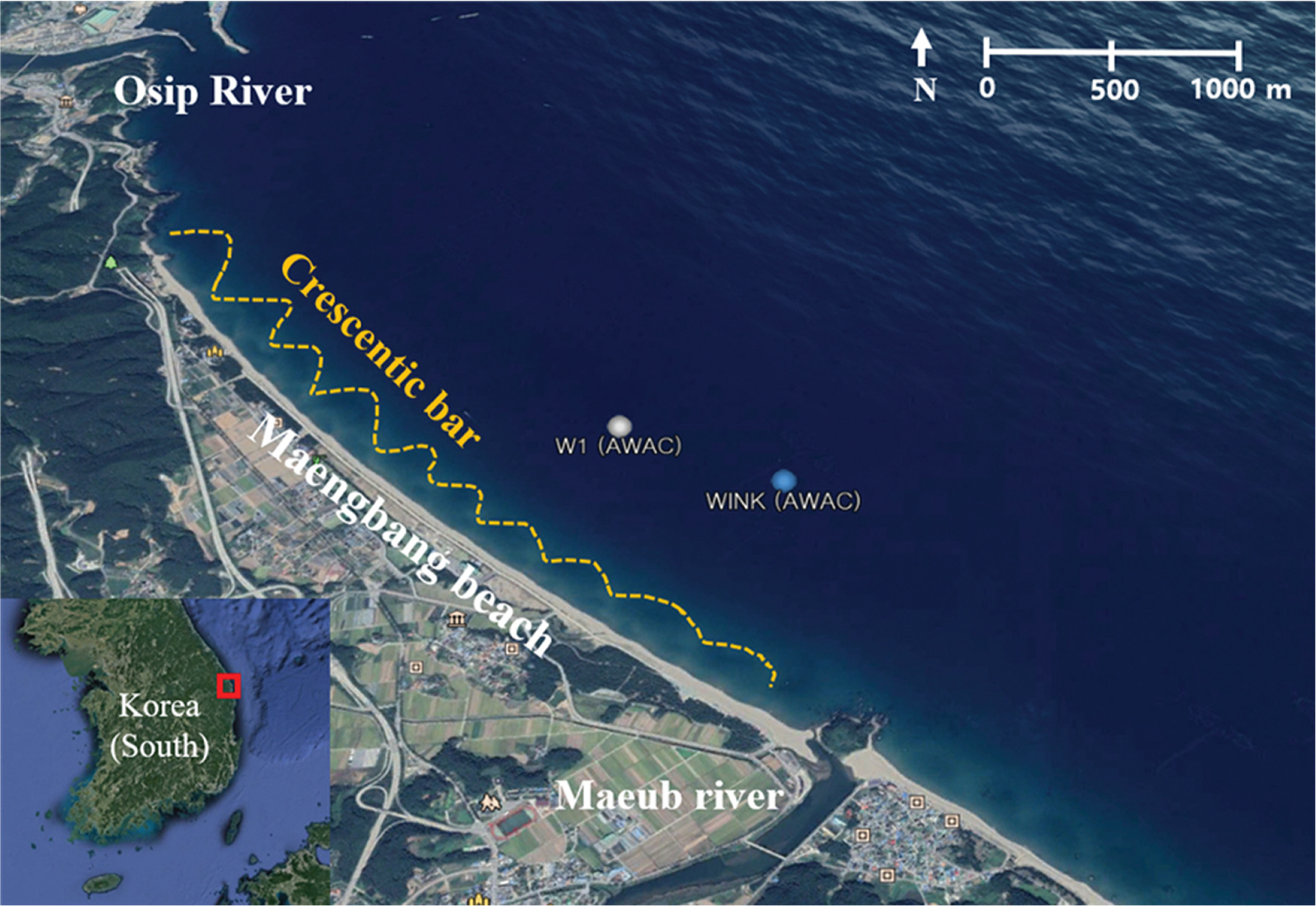
Fig. 2.Left: Significant wave height, peak period, peak direction (based on shore normal direction), and alongshore component of the wave energy flux at WINK (AWAC, Fig. 1) during Nov, 2013∼Sep, 2019, Right upper panel: Wave rose (Apr∼Sep), Right lower panel: Wave rose (Oct∼Mar) with a red arrow that indicates average shore normal direction (41.6°). 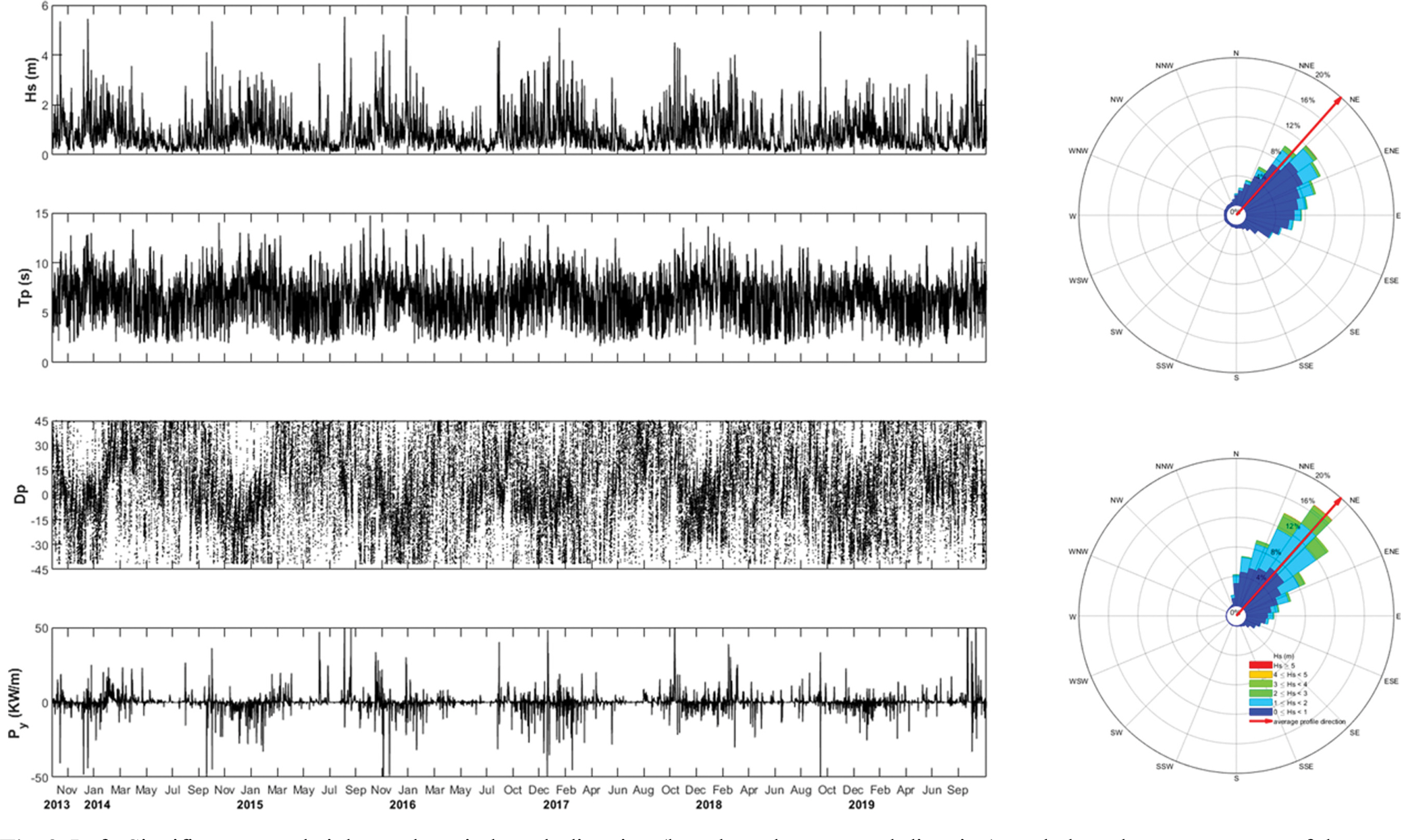
Fig. 3.Left: Significant wave height, peak period at W1 and WINK (AWAC, Fig. 1), and peak direction at W1 included four series of typhoons (Lingling, Tapah, Mitag, Hagibis), Right: Tracks of four typhoons. 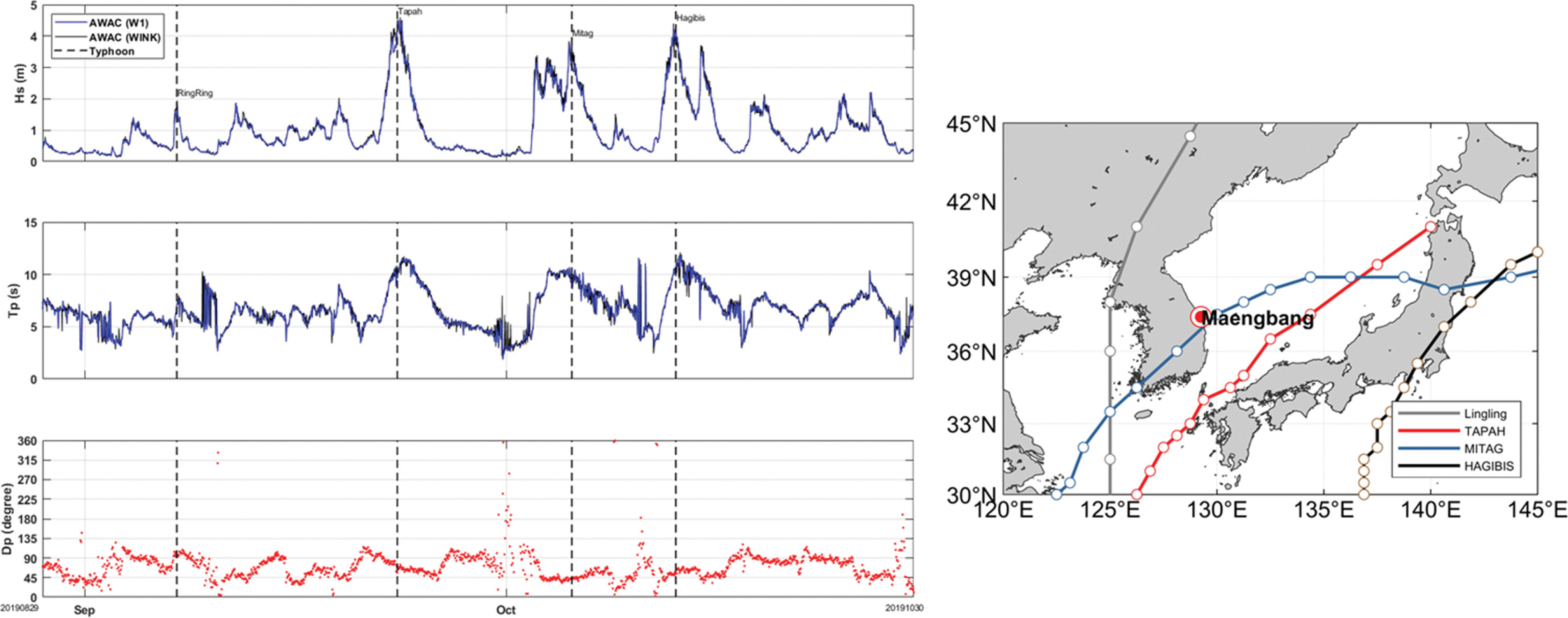
Fig. 4.(a) Maengbang beach with Crescentic bar and (b) longshore uniform bar due to series of storms (from Google Earth), (c) Mean Topography, and (d) Elevation difference (ΔZb) of measured and simulated bed level between Aug 29 and Oct 30 in 2019, which denotes positive value (accretion) and negative value (erosion). 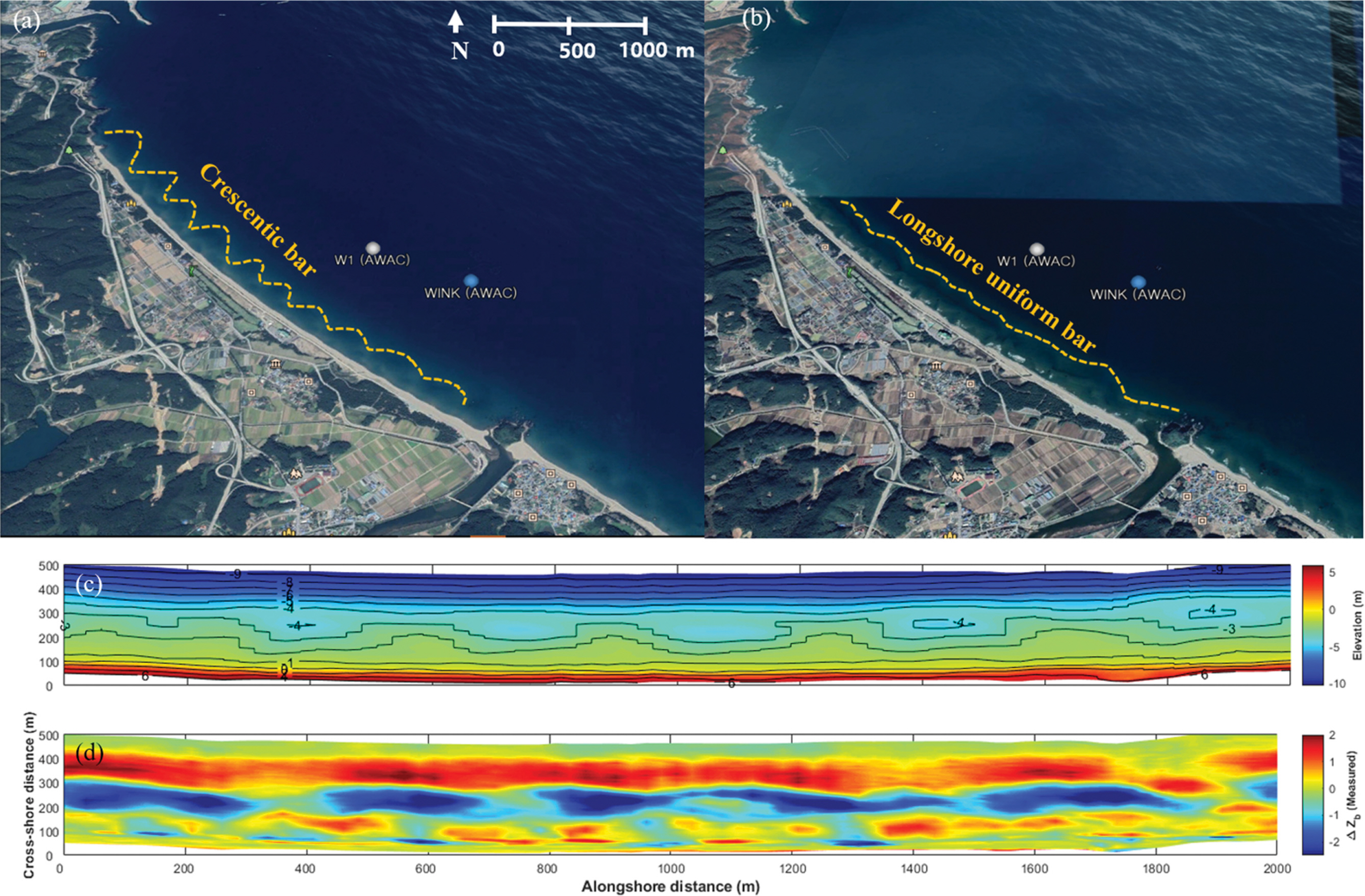
Fig. 7.Median grain size (unit: mm) observed on 29 Jul, 2019 at each point (A01∼L04, total 48 points) and contour plot (29 Aug, 2019). 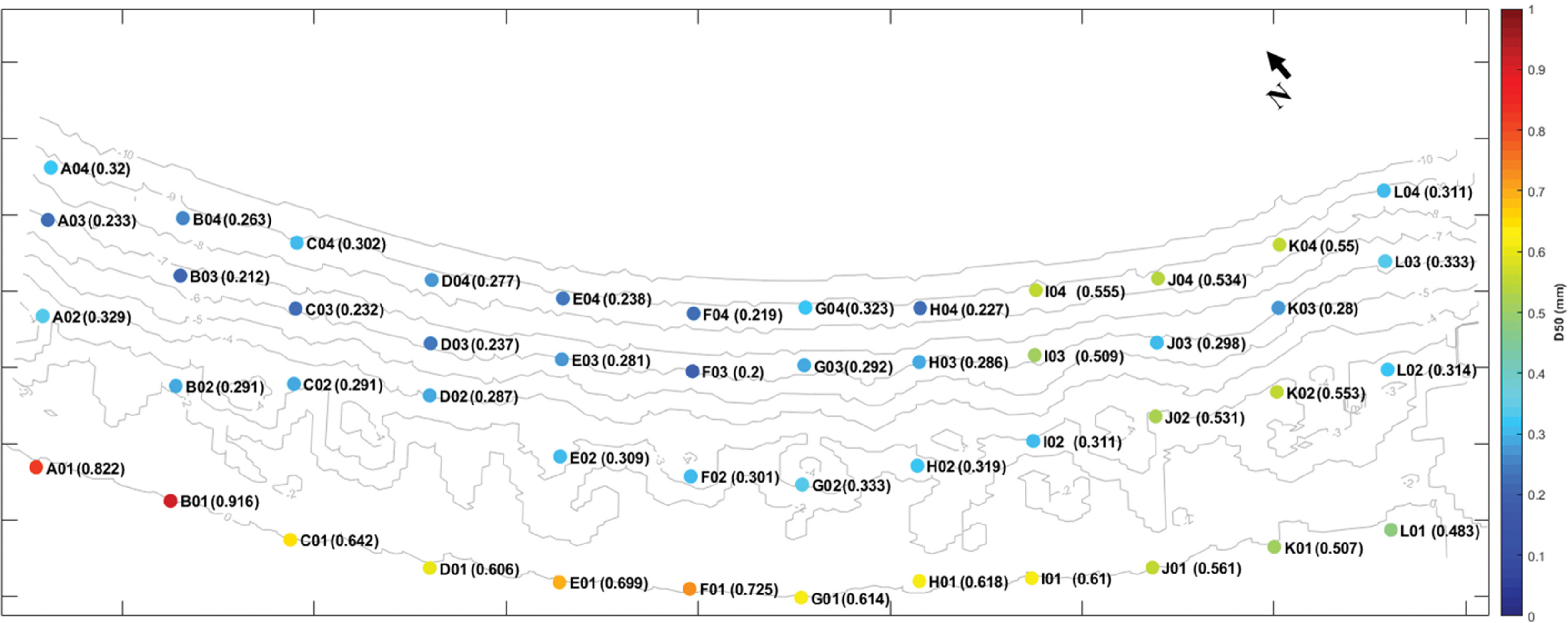
Fig. 8.Cummulative elevation differences (ΔZb) of typhoon periods during each maximum significant wave height (positive - accretion, negative - erosion) and direction of sediment transport (black arrow) with magnitude (size of arrows, unit: m2/s) : contour line (initial bathymetry). 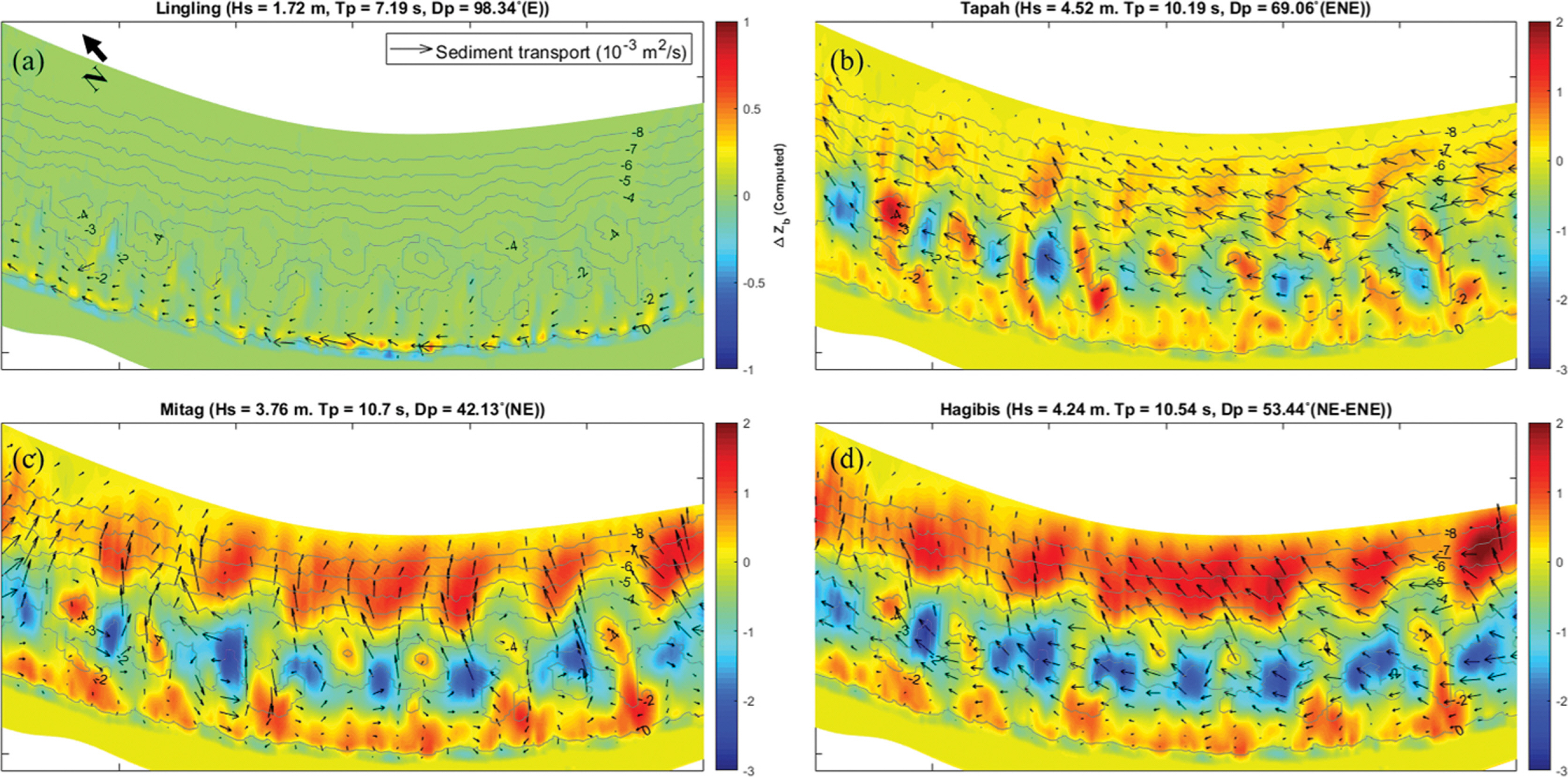
Fig. 9.BSS values of each beach profile in a numerical grid (Top panel), Elevation difference of pre & post-storm bathymetries (observed -middle panel, computed - bottom panel with representative eroding and accreting profile). 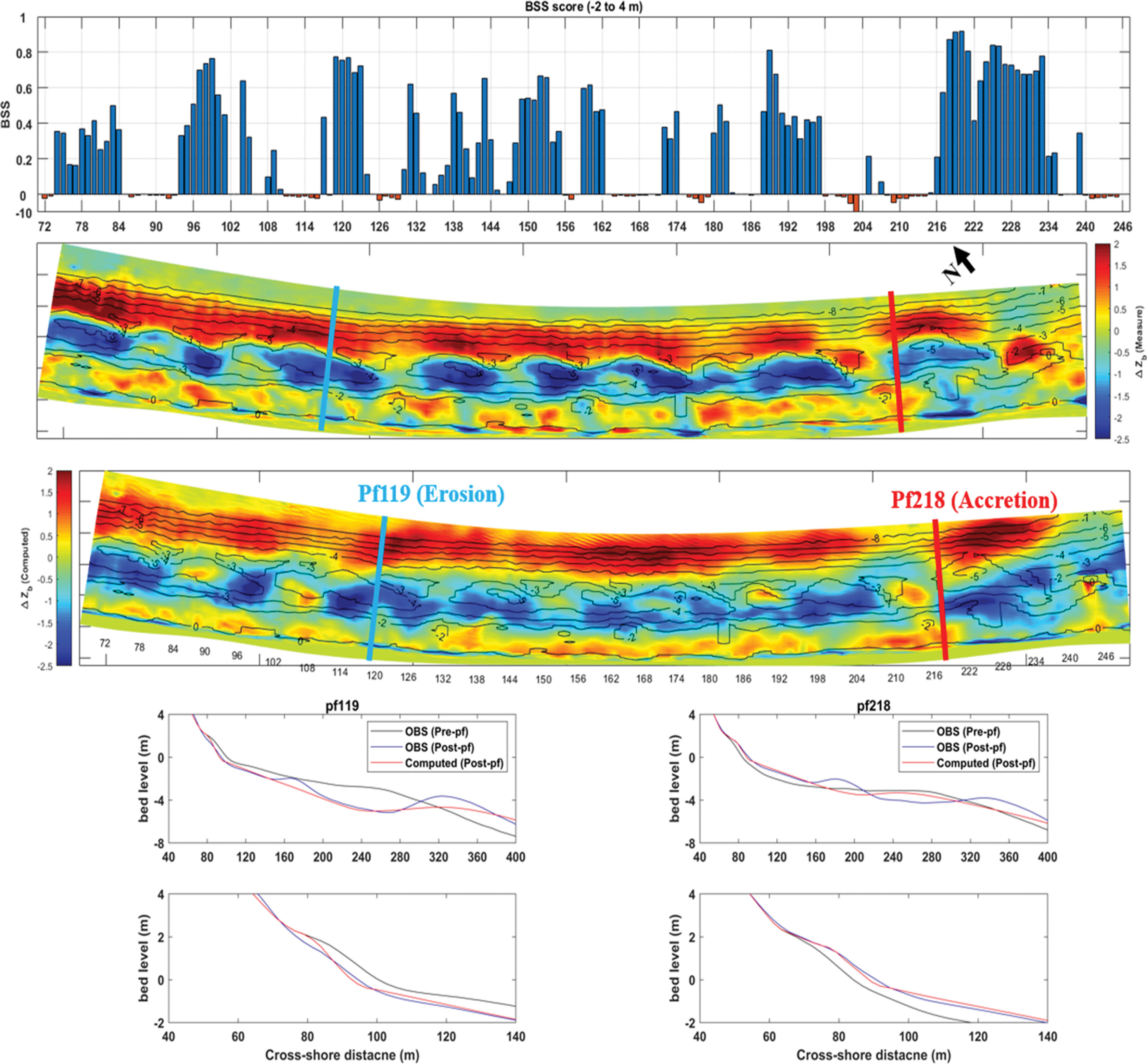
Table 1.Typhoons that impact to maengbang beach during Sep∼Oct in 2019 and characteristics at each storm peak Hs Table 2.Settings of XBeach Parameters for calibration processes
ReferencesAthanasiou, P. (2017). Understanding the interactions between crescentic bars, human interventions and coastline dynamics at the East coast of South Korea. MSc thesis. Delft University of Technology, Delft.
Castelle, B., Marieu, V., Bujan, S., Splinter, K.D., Robinet, A., Sénéchal, N., Ferreira, S (2015). Impact of the winter 2013–2014 series of severe Western Europe storms on a double-barred sandy coast: Beach and dune erosion and megacusp embayments, Geomorphology, 238, 135-148.
Castelle, B., Ruessink, B.G., Bonneton, P., Marieu, V., Bruneau, N., Price, T.D (2010). Coupling mechanisms in double sandbar systems. Part 1: Patterns and physical explanation, Earth Surface Processes and Landforms, 35(4):476-486.
Chang, Y.S., Jin, J.Y., Jeong, W.M., Do, J.D (2017). Numerical investigation of the impacts of extreme storm waves on coastal erosion in Hujeong Beach using XBeach model, Journal of Coastal Disaster Prevention, 4(4):197-206.
Cho, Y.J., Kim, I.H (2019). Preliminary study on the development of a platform for the selection of optimal beach stabilization measures against the beach erosion - centering on the yearly sediment budget of mang-bang beach, Journal of Korean Society of Coastal and Ocean Engineers, 31(1):28-39 (in Korean)..
Daly, C., Roelvink, D., van Dongeren, A, van Thiel de Vries, J, McCall, R (2012). Validation of an advective-deterministic approach to short wave breaking in a surf-beat model, Coastal Engineering, 60(1):69-83.
De Vet, PLM. (2014). Modelling sediment transport and morphology during overwash and breaching events. MSc thesis. Delft University of Technology, Delft.
Deltares. (2018). XBeach Documentation, Release XBeach v1.23.5527 XbeachX FINAL. Deltares, Netherlands.
Do, K., Shin, S., Cox, D., Yoo, J (2018). Numerical simulation and large-scale physical modelling of coastal sand dune erosion, Journal of Coastal Research, 85, May). 196-200.
Do, K., Yoo, J (2020). Morphological response to storms in an embayed beach having limited sediment thickness, Estuarine, Coastal and Shelf Science, 234, 106636.
Elsayed, S.M., Oumeraci, H (2017). Effect of beach slope and grain-stabilization on coastal sediment transport: An attempt to overcome the erosion overestimation by XBeach, Coastal Engineering, 121, 179-196.
McCall, R.T., Van Thiel de Vries, J.S.M., Plant, N.G, Van Dongeren, A.R, Roelvink, J.A, Thompson, D.M, Reniers, A.J.H.M (2010). Two-dimensional time dependent hurricane overwash and erosion modeling at Santa Rosa Island, Coastal Engineering, 57(7):668-683.
Orzech, M.D., Reniers, A.J.H.M., Thornton, E.B., MacMahan, J.H (2011). Megacusps on rip channel bathymetry: Observations and modeling, Coastal Engineering, 58(9):890-907.
Passeri, D.L., Long, J.W., Plant, N.G., Bilskie, M.V., Hagen, S.C (2018). The influence of bed friction variability due to land cover on storm-driven barrier island morphodynamics, Coastal Engineering, 132, 82-94.
Pender, D., Karunarathna, H (2013). A statistical-process based approach for modelling beach profile variability, Coastal Engineering, 81, 19-29.
Razak, M.S.A., Dastgheib, A., Suryadi, F.X., Roelvink, D (2014). Headland structural impacts on surf zone current circulations, Journal of Coastal Research, 70, 65-71.
Roelvink, D., McCall, R., Mehvar, S., Nederhoff, K., Dastgheib, A (2018). Improving predictions of swash dynamics in XBeach: The role of groupiness and incident-band runup, Coastal Engineering, 134, 103-123.
Roelvink, D., Reniers, A., van Dongeren, A, van Thiel de Vries, J, McCall, R, Lescinski, J (2009). Modelling storm impacts on beaches, dunes and barrier islands, Coastal Engineering, 56(11–12):1133-1152.
Roelvink, J.A (1993). Dissipation in random wave groups incident on a beach, Coastal Engineering, 19(1–2):127-150.
Smit, M, Reniers, AJHM, Stive, MJF. (2010). What Determines Nearshore Sandbar Response? Proceedings of 32nd Conference on Coastal Engineering. Shanghai, China: 1-7.
Son, S., Kim, J., Yoon, H.D., Jung, T.H., Do, K., Shin, S (2017). An Observational and numerical study of storm-induced morphologic changes at sanpo beach, Korea, Journal of Coastal Research, 33(Special Issue 79):334-338.
Soulsby, RL. (1997). Dynamics of Marine Sands. Thomas Telford Publications, London.
Van de Lageweg, W.I, Bryan, K.R, Coco, G, Ruessink, B.G (2013). Observations of shoreline-sandbar coupling on an embayed beach, Marine Geology, 344, 101-114.
van Enckevort, I.M.J, Ruessink, B.G, Coco, G, Suzuki, K, Turner, I.L, Plant, N.G, Holman, R.A (2004). Observations of nearshore crescentic sandbars, Journal of Geophysical Research C: Oceans, 109(6):1-17.
van Rijn, L.C, Wasltra, D.J.R., Grasmeijer, B, Sutherland, J, Pan, S, Sierra, J.P (2003). The predictability of cross-shore bed evolution of sandy beaches at the time scale of storms and seasons using process-based profile models, Coastal Engineering, 47(3):295-327.
van Rijn, L.C (2007). Unified view of sediment transport by currents and waves. III: Graded beds, Journal of Hydraulic Engineering, 133(7):761.
|
|
||||||||||||||||||||||||||||||||||||||||||||||||||||||||||||||||||||||||||||||||||||